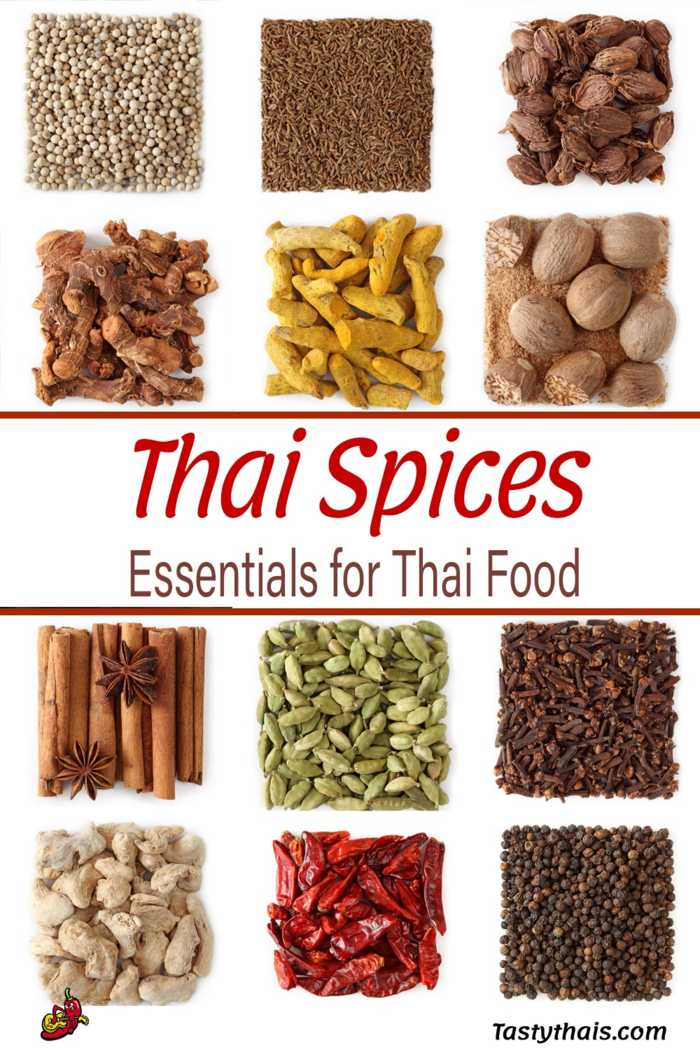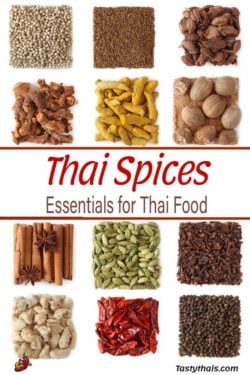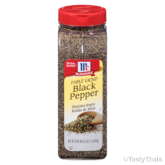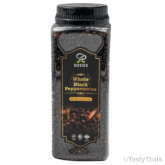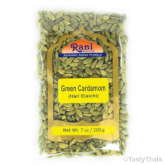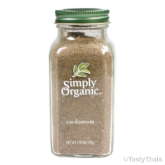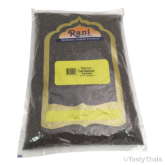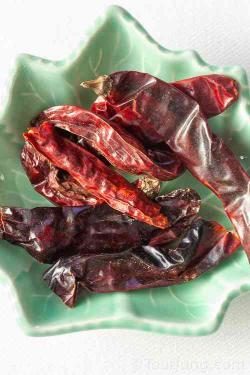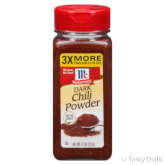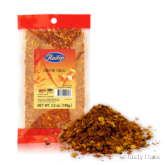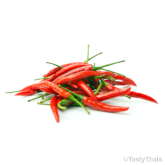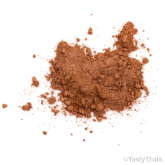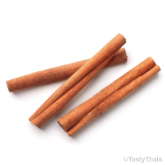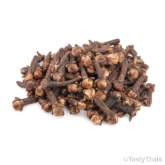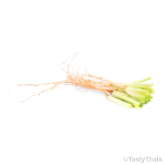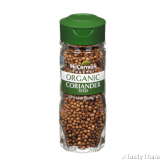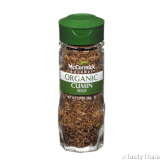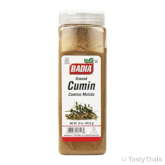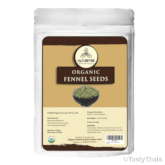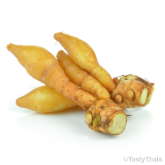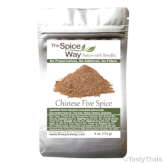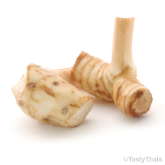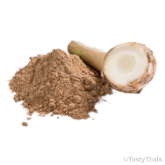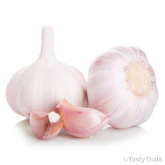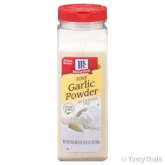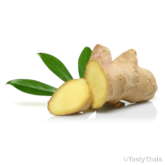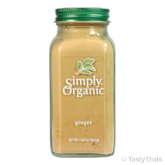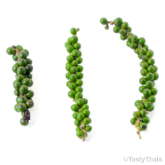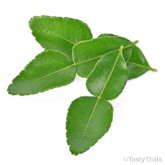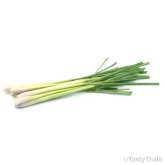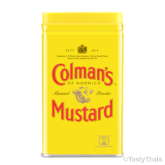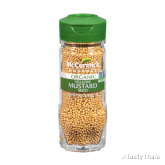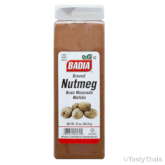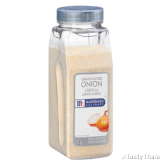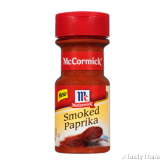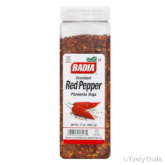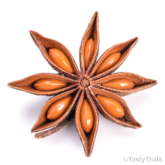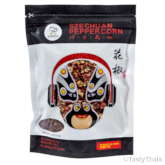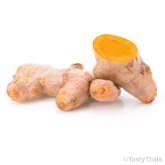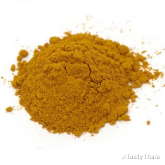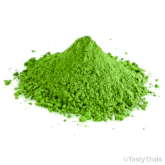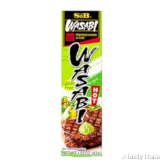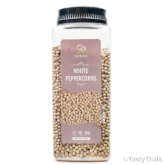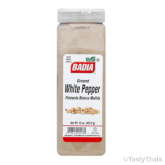Thai spices are one piece of the jigsaw that makes Thai food one of the most renowned cuisines in the world. They are just a part of the bigger picture of Thai cuisine but as a group Thai spices are essential Thai food ingredients.
Here’s a question you might rightly ask – Is all Thai food spicy? Check that link to see why the answer is no – but nearly all Thai food contains spices.

Thai Spices – Origins in Brief
One thousand years ago the Khmer empire encompassed most of the Thailand of today as well as what is now Cambodia and part of today’s Vietnam.
Vibrant trade routes bought with it culinary influences from China to the East, India to the West, and Malaysia to the South (also heavily influenced through trading partnerships with India).
So it is no surprise to find similarities in what is today’s Thai food embracing culinary features of all the regions around it.
Later trade with the Portuguese brought European influences too in some of the herbs and spices used in today’s Thai cooking (and the Sino architecture especially in Phuket).
In the Table of Thai spices below, you’ll find many spices that are common to other styles of cooking and dishes. The Penang Curry from Malaysia, Ba Mee Noodle soup, and more from China, Vietnamese Po which equates to Thai Boat Noodles, fermented fish paste (kapi) from Cambodian cuisine which is a staple of north-eastern Thai cuisine and so on.
All these regional influences together with the adaptations made over the centuries and decades are responsible for the flavors of Thai food today.
We covered the definition of Spices in our Ingredients post but it bears repeating on this dedicated page too.
What is Spice?
Spice is a fragrant, aromatic, or pungent part of a plant that is in broken or dried form which may also be ground into a powder. Its primary function is to enhance the flavor of a dish rather than add nutritional value.
Bear in mind that for the purposes of classification at TastyThais, spices are single ingredients and if part of a mix or blend in liquids then you will find them explored in our Thai seasonings article.
Table of Thai Spices
Notes: The usage column gives an idea of how often a spice is used. The Note column links work similar to the Table of Contents. The spice name links to an online source (Amazon, Walmart etc,) where you can get a better look at the spice, the latest information, and availability.
Thai Spices A – C
Black Pepper – Ground
Ground black pepper is much less commonly used than black peppercorns except in restaurants serving international guests. It is sometimes added to soups as a final seasoning but this is the exception more than the norm.
Ground black pepper is also sometimes used in spice mixes and to season meat before cooking as you would use a rub in the US.
Black Peppercorns
If a Thai cook wants pepper in a dish then black peppercorns are going to be the thing they pick up. Thrown into the mix with other spices, the peppercorns are then smashed and ground with the pestle to release their flavor as fresh as can be.
You will also find peppercorns added to broths as a base for soups and for some peppery seasoning.
Cardamom Pods
Cardomom pods are the seed containers produced by the plant. In the West, you will possibly be familiar with cardamom seeds more than the pods.
Thai cooks use cardamom pods whole in curries which are eaten by some people and avoided by others. They are quite hard when dried but soften with cooking so you can easily bite down on one by mistake, They have quite a strong flavor but are not very ‘hot’ as in chili heat.
These pods introduce a definite flavor to the dishes they are used in and quite commonly used.
Cardamom Powder
The only use for this is in commercial production or high traffic restaurants where it may be used to produce pastes.
Cardamom seeds lose their potency quickly once ground so if ground cardamom is to be used in a recipe then the seeds will be dry roasted and then crushed with a mortar and pestle or grinder for much better flavor.
Cardamom Seeds
The most common culinary use is for the seeds to be ground up with other ingredients to make massaman curry paste. They are sometimes also found in other Thai curries and braised dishes but not often.
More commonly Thai cooks will buy cardamom pods and remove the seeds when they want to use them.
Cardamom seeds are used for medicinal purposes quite commonly in Thailand.
Chilies Dried Whole
Whole dried chilies are used to add color to a dish and some light heat.
The seeds are quite spicy and you can tap these out if you prefer a less hot curry since some will fall out during cooking.
The dried chilies are not meant to be eaten but set aside in the dish as you uncover them whilst eating.
Chili Powder
Chili powder in the finely ground form such as you see with paprika or ground white pepper is very rarely used in Thai cooking.
The reason is that chili flakes are already to hand for so many uses that these are used instead.
Chili Flakes
Dried chili flakes are very commonly used both in cooking and at the table to add spice – especially to Thai soups like Khao Tom.
Chili flakes are also used to make pastes of various sorts that are used as a base for dishes although fresh chili is more commonly used for this purpose.
Fresh Chili
For fresh chili use please refer to our page on Thai vegetables.
We decided to classify chili there because there are many types and not all of them are spicy. In reality, they are a fruit but then that’s just being pedantic!
Check out our Guide to Cooking with Chili Peppers for potential local substitutes.
Cinnamon Powder
This is not commonly used though some cooks use it when making a massaman paste and also for some specialist uses.
Cinnamon Stick
The sticks of cinnamon are more often added as a flavoring to soup broths and some curry dishes to add flavor and then removed before serving.
They are quite handy to have on hand and have other culinary uses. Often served with coffee in upmarket establishments.
Cloves
Another common spice in the West but much less often used as an ingredient in Thai dishes. It is however used in making massaman curry paste by quite a lot of Thai cooks.
Coriander or Cilantro Root
There are arguments to include this under spices but we decided to list it under Thai herbs along to keep it all together.
Coriander Seeds
A very common ingredient in many pastes and ground up in several Thai dishes.
It is also very commonly used by use to toast along with cumin seeds, grind and then add to shop-bought red curry paste to bring it to life and liven up the ingredient.
Cumin Seeds
This wonderful spice is a staple in Indian cuisine and so it is a common ingredient in Thai dishes and used to make red curry paste (as well as enliven shop-bought curry pastes). Very common.
Cumin Powder
Much less often used by Thai chefs because the flavor is just not there when compared to cumin seeds that are ground fresh.
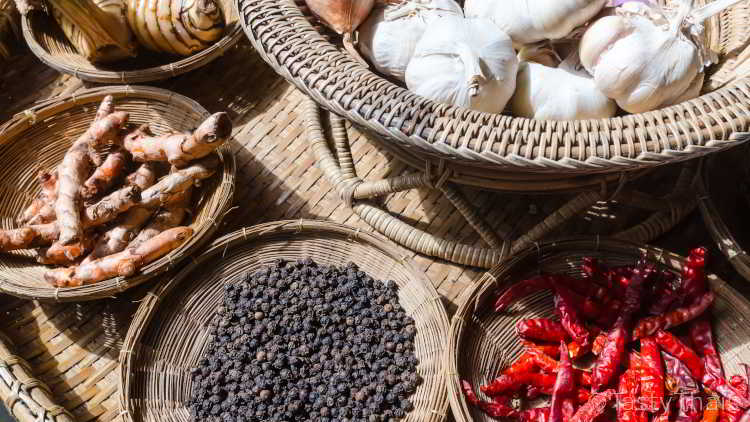
Thai Spices D – G
Fennel Seeds
Fennel seeds are not terribly common in most Thai dishes but is used is several southern Thai Muslim curries and in some Phuket style dishes.
This is a great spice that is much underused in traditional widespread Thai dishes.
Fingerroot – Fresh
Fingerroot is something of a secret for Thai dishes. With a similar taste to ginger and also called Chinese ginger, it is used in quite a lot of Thai recipes and especially those that have Chinese influences.
So called because the roots extend like fingers from a central stem, this variation from the same family as the ginger plant has many renowned medical benefits.
It has a milder taste than ginger and provides a gentle nuance to soups and curries.
Five Spice
This is a mix of spices and so listed under seasonings.
Galangal – Fresh
This rhizome (horizontally growing tuberous root)is a very common ingredient in Thai dishes and although a cousin to ginger has a much different taste.
Nevermind what anyone says – you cannot substitute galangal with ginger.
Super common and has its own special flavor that you will need to source if you want to cook real Thai food.
Galangal Powder
It is used but much less often outside of commercial production and lazy kitchens.
Galangal powder has much less potency and loses most of its aroma when powdered and stored so only use it as a last resort if you want to try to add flavor because you just cannot obtain fresh. You will not achieve your goal but, hey, gotta make an effort right?
Garlic – Fresh
Garlic is perhaps the most common spice used in Thai cooking. Now I fear an argument on whether garlic is a spice because it is fresh and if chili isn’t here bla bla bla. I get it – really I do but here it is and here it stays.
You will find garlic in almost every savory dish – automatically added akin to fish sauce. it is ubiquitous and essential and lasts long (outside the fridge please). Get plenty because it is really good for you by all accounts too.
Garlic Powder
More common than you might expect and used in dry spice and seasoning powders that are then added as seasonings to various dishes.
Ginger Root – Fresh
Fresh ginger root is another wonderful spice that there will be arguments about including here. But anyway, this rhizome has a definitive heat to it quite different to chili heat and with a zing that is not there with its milder cousin galangal.
Very commonly used with whole dishes revolving around it such as Pad Prik King for example.
Another extensively used spice that is reportedly very good for your body and also a component in many Asian herbal remedies. Get it and use it.
Ginger Powder
Less commonly used except where a dry mix is being concocted for seasoning. It is handy to have on hand and can be used for baking so you may as well grab some. You will find it is sometimes used to make pastes but fresh is more common except in commercial production.
Also handy when it turns out the ginger you thought you had is missing from the fridge but is much less potent in use.
Green Peppercorns
Green peppercorns have been used in Thai cooking for millennia and were the go-to ingredient to add chili type heat until chilies arrived thanks to Portuguese traders and rapidly became used in preference.
Many Thai dishes still use green peppercorns which are added as a bunch to curries and stir-fries and actually bravely eaten by spice addicted Thais – most of us will set most of it aside though.
Green peppercorns are actually the fresh, unripe version of white peppercorns and white peppercorns are the partly ripened peppercorns before the sun finally turns them into black peppercorns – so there!
From this fact, you can probably deduce you can get away with subbing black or white peppercorns for taste but they will be the devil to pick out before serving!
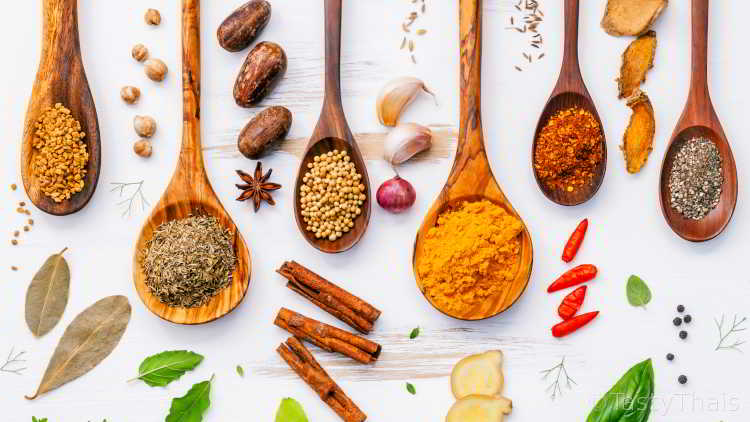
Thai Spices H – R
Kaffir Lime Leaves
Our zesty spice-like friends are to be found in our page on specials.
Lemongrass
Another sort of spice like ingredient but not really so we put it with specials too.
Mustard Powder
Uncommonly used but can be found added to soy sauce as a condiment. No need to bother with it though.
Mustard Seeds
Uncommonly used but sometimes added to stocks and broths for taste depending on the cook. Another spice that is not essential.
Nutmeg
Whole and grated or powdered it is used in some chefs massaman and other Indian style curry recipes but otherwise not so common in Thai savory dishes.
It is used in some spice mixes though and in baking and fusion dishes so it is worth having.
Onion Powder
Onions are a Thai staple but onion powder is rarely added as an ingredient on its own. It is used for making spice mixes which are then used so again you will probably end up using it.
Paprika
I have seen it used to make some pastes but more for coloring than taste. Since it is a common ingredient in many dishes of other cuisines you will probably have it anyway.
If a Thai cook wants heat then dried chili flakes is what they will reach for unless they are looking for a very smooth style paste.
Red Pepper Flakes
The red pepper flakes you buy from the store are very mild and not going to be found in most recipes.
But – if you are starting out cooking Thai food or cannot tolerate spice then you can use red pepper flakes as a sub for dry chili flakes.
It won’t taste the same but it will be milder.
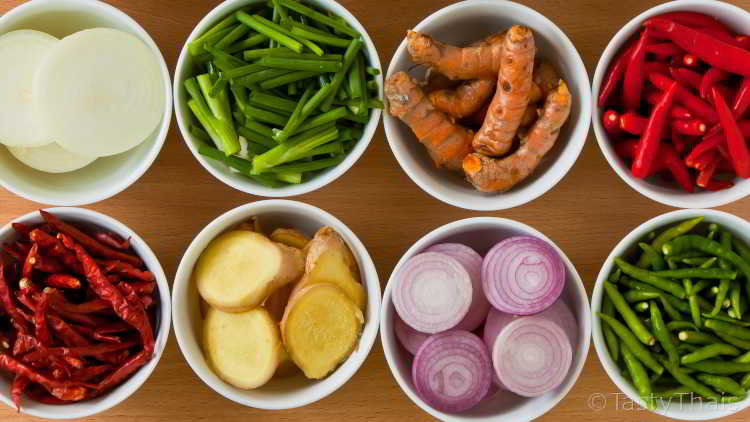
Thai Spices S – Z
Star Anise
Star anise is commonly used to flavor Asian broths and stock and is an essential ingredient.
More used in Chinese than Thai cooking but used often enough and with enough of a unique taste that you should have it on hand.
Its pleasant licorice flavor is made use of for five-spice powder and it is used in a few Thai dishes such as Kha Moo (braised pork leg).
Sichuan Peppercorns
Used often in northern Thai dishes for its spiciness and much different taste to black peppercorns.
It is a core ingredient in Mala Seasoning which is used as an ingredient as well as a fiery powder to dip blander foods in such as tofu to give it flavor.
Thai people hate food that is basically tasteless.
Turmeric – Fresh
A wonderful ingredient with amazing reported heath qualities and a great yellow color which is used very often.
This is one of the ingredients harder to find in the West but is really one worth searching out as it adds both distinctive color and taste to a dish.
Avoid buying it until you need it though as it will only last a week or too similar to ginger and galangal.
Turmeric Powder
For the same reasons of freshness so important to Thai ingredients, turmeric powder is less commonly used than fresh turmeric which is readily available.
Turmeric is used in many yellow curries such as pat pong kalee and to make yellow curry paste and the powdered form can be used in place of fresh quite readily. Remember though fresh is always best.
Turmeric powder is used in the commercial production of various seasoning powders and as an ingredient in pastes.
Wasabi Powder
Thai people love to snack. Nuts and other small pickings are often dusted in wasabi powder to spice them up.
So if you are looking to sometimes make Thai snacks then you might need it. You could, of course, use hot mustard powder instead.
Or you can mix it with water to make wasabi paste – see below
Wasabi Paste
Thai dumplings are sometimes fried like gyoza and in fact, the Japanese gyoza has been somewhat incorporated into Thai food – at least in the cosmopolitan cities.
Wasabi paste is mixed with soy sauce to make the dipping sauce that is most often served with these fried dumplings.
White Peppercorns
Black peppercorns are more often used than white peppercorns but in some dishes, you will be looking to avoid the black specks that ground black pepper produces.
White peppercorns are slightly less flavorful from a flavor complex point of view but somewhat hotter in a peppery heat way than black peppercorns – and of course a different color.
In fact, white peppercorns are picked before the sun has fully ripened the corns and turned them black – a bit like olives really!
White Pepper Powder
White pepper powder is a common ingredient in Thai recipes. You can, of course, grind white peppercorns if you have them handy but if you are only using a small quantity for dusting or a little recipe tweak then you can get away with the pre-ground pepper.
It is also used in spice mixes that are used as seasonings so it really is an essential ingredient.
